White Markings
Based on information from the NPS and FPS Stud books:
1923 to 1927 and 1985 to 2002
INTRODUCTION
This study was made in 1997, initially as an exercise for a Royal Society of Arts course in Information Technology. I required data to analyse and make into spreadsheets and charts, and chose a subject in which I was interested, namely the Fell pony and its coat colours. Fells are an easy breed for this purpose because their coat colours are limited to black, brown, bay and grey. No other colours are eligible for registration. This made analysis of the data relatively simple.
I extended the exploration to look at white markings, out of curiosity. White markings in the Fell are restricted to a small star and/or a little white on the hind foot, not extending above the pastern joint. No value judgements were made; it was not assumed that white markings are “A Bad Thing” in themselves. It was simply another feature to consider and one which, thanks to the conscientiousness of the Fell Pony Society’s stock-recording in recent years, was easy to investigate.
In the past, ponies of any age might be registered with the Fell Pony Society, and between 1940 and 1970 there was also an Inspection Scheme by which typical stock whose pedigree was unknown might be given limited registration papers. This broadened the gene pool at a time when the Society felt that good Fell stock might well be lost to the breed simply through lack of recorded pedigrees. Mares were inspected by two FPS judges and if passed were registered as Inspected Stock (IS). Only the filly foals might be kept for breeding, colts having to be gelded before registration. The offspring were recorded in the Stud Book as A (first cross from IS) and B registrations (out of an A registered mare). Subsequent generations were given full papers.
The Society now records the name, ancestry, sex, colour, and markings of foals, and of young stock under 18 months (the extension applying solely to hillbred young stock). There is therefore detailed paperwork to fill in and a fee to pay for each pony registered. The offspring of unregistered stock, and ponies over 18 months old, may not now be registered, no matter how typical. In future years, due to new EU regulations, the time scale will change again; foals will have to be registered in their year of birth up to 31st December.
Since 1980 all markings have been recorded and published in the Fell Pony Society's own Stud Books; if a pony has been blood typed, and microchipped, this is now indicated. However, the full details of such records as DNA testing might not always be published in the Stud Book as space is limited.
In earlier records (the Black Stud Book covering 1898 to 1980) which were collated by the FPS secretary from National Pony Society registrations, such things as white markings were not always published. This point made comparison of old data and new data difficult.
The following information may be regarded as a guide only, to recent trends within the registered stock of the Fell pony.
COLOUR DISTRIBUTION 1923-1927
The Fell Pony Society made a big effort to encourage more people to support the breed in 1922, and its membership increased by 29 in 1923.
Volume XIX of the National Pony Society records show that, between 1923 and 1927, 43 Fell stallions/colts and 85 mares/fillies were registered.
The proportion of black ponies (46% of the total registrations) is only slightly larger than that of brown (43%); bay (8%) was a more frequent colour for mares than for stallions; 4 black-and-white ponies were registered (3%); and there were no greys. In other NPS volumes grey and dun were registered (dun was recognised as an intractable type temperamentally), red and blue roan too, and I also know of a few pure-bred animals from the last 30 years which were closer to liver chestnut than to brown. [I do not know how common such unregisterable colours may be. I have only seen one personally but know of the others from their breeders' remarks.]
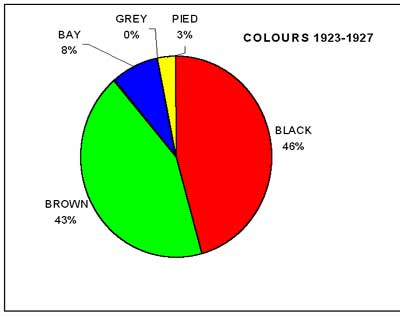
COLOUR DISTRIBUTION 1985-2002
The trend in the period 1983-1992 was for an increase in registrations. More fillies than colts were registered each year. However, registrations of colts had increased in 2002 compared to that of fillies, when the numbers of colts and fillies were almost equal (143 and 151).
Black, bay, brown and grey are the only permitted modern colours. The proportions of the colours in both sexes were very similar each year during this period.
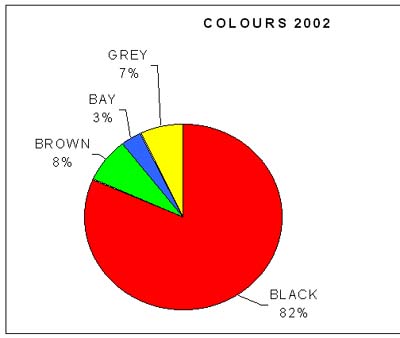
Black is now the predominant colour in the Fell pony but all coat colours are still represented. Brown, bay and grey together account for approximately 20% of registrations and the other 80% of ponies registered are black. "Brown" is a slightly misleading term as it may be used to describe quite a bright bay and it may be worthwhile adding those two colour values together for a clearer picture. Bay or grey are occasionally absent from one year's registrations in either sex.
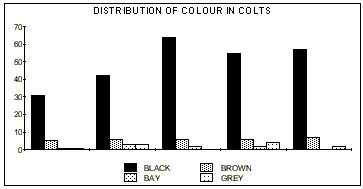
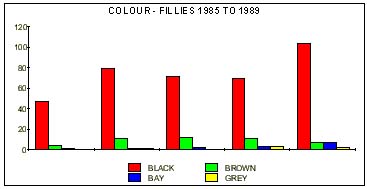
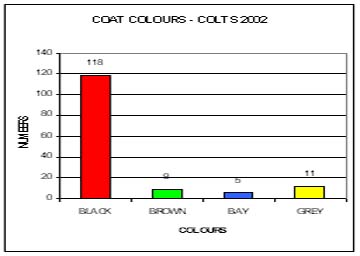
The coat colours remained more or less in the same proportions in this period, with black predominating.
I examined another series of data for a ten year period (1983-1992). 2,317 fillies or mares were registered in total, which is more than twice as many as the registrations of stallions, colts and geldings (1,070). This is similar to the balance of female:male registrations in Volume XIX. Registrations in the early part of the period 1985-1989 included some older stock. Later registrations were confined to yearlings and foals.
In 2002 however, the numbers registered were almost equal: 151 fillies and 143 colts.
WHITE MARKINGS
It is worth repeating at this point that this study is not meant as a condemnation of white markings, which are evident throughout the breed's history and are permitted by the Society's rules. Good ponies are good ponies, and white markings are only incidental. Stallions with white markings were relatively common in the 1920s registrations. 23% of those in Volume XIX had a white foot, compared with only 12% of the mares. One mare and one stallion had a white front foot.
POPULAR BLOODLINES
Popular bloodlines with a lot of progeny will always be prominent in any list, so it was necessary to establish whether the apparent predominance of certain bloodlines in the white footed foals between 1983 and 1992 was simply because of their high production of Fell ponies in general.
On investigation, these bloodlines were equally strongly represented as producers of whole-coloured ponies with no white. The evidence pointed rather to them simply being popular bloodlines and therefore providing more examples.
There were stallions that produced both white and black feet. Those producing most foals actually may not have as large a percentage of white footed offspring as do stallions which produce few foals. This is because where small numbers are involved, they inevitably skew the data. For instance, if a stallion sired only one registered foal, which had a white foot, his proportion of white footed offspring would be 100%. If another sired 12 foals and 3 had white feet, his proportion would be much less at 25% although the number of white footed foals sired by him is greater.
It was also clear that studs use stallions both of their own breeding and that of others, regular exchanges taking place between breeders. Stud prefixes cannot be linked with the production of particular markings.
I had no way of computing the significance of the stallion and mare lines together, so this line of investigation was abandoned.
SIMPLIFYING THE DATA
I decided to concentrate on three years in the FPS Stud Books, 1983, 1992 and 2002, and compare the percentage of fillies registered which showed white on a hind foot.
Year |
Number registered |
White marked foot/feet |
Percentage of white marked feet |
1983 |
85 |
9 |
10.6% |
1992 |
161 |
20 |
12.4% |
2002 |
151 |
26 |
17.2% |
Although registrations have dropped a little, the percentage of white marked feet has increased. However, the fillies' markings are still below the 23% mark noted for stallions in Volume XIX.
A CONTINUING PUZZLE
It must be emphasised that this survey has not been in any way exhaustive, nor statistically analysed other than by basic charting. I have simply looked at data in the Stud Books, without value judgements.
Questions arise from the information in the Stud Books.
Unfortunately, in Volumes 44, 45 and 46 (1974-1980) no markings are recorded. The apparent absence of white in those published registrations may due to any one of several administrative reasons, or it may be an actual, though unlikely, fact. Most probably the occurrence of white feet was recorded on individual certificates; but for my purposes the information was not at hand in the Stud Book.
The apparent increase of white feet in recent decades may be due to ponies now being described in closely monitored conditions in stable, field or in-bye land, rather than being observed in semi wild conditions where muddy ground may have obscured the smaller kinds of white markings on the feet; or to increased emphasis on the recording of such details by the Council, Secretary and breeders. There is an increase in white feet through the 1980-2002 Stud Books, where such details are recorded with great punctiliousness.
Where did the increase come from? There are several possibilities.
1. It may trace back to Inspected mares. It was not unknown for cart mares to be put out onto the fell where they might well have been covered by a Fell stallion and produced a typically black filly foal, whose offspring might later have been papered through the Inspection scheme. Such characteristics as white feet might then have skipped one or two generations and thus shown up in foals with apparently pure Fell pedigrees.
2. It may trace back to Dales blood which is also known to contain a Clydesdale influence.
3. It may be due to the influence of a popular stallion whose background traces back to the stallions of early times - where, as can be seen from the Volume XIX registrations, white feet were not uncommon. (If you feel it necessary, you can survey all those early volumes and chart the incidence of white feet over most of the breed's 100 years of registrations!)
4. It may reveal piebald or skewbald influence, either in the distant past or more recently (see point 1). The first cross of a piebald stallion on a Fell mare or vice versa may produce a whole coloured foal with two white hind socks, or a whole coloured foal - even several generations of whole coloured animals - with no markings, that subsequently throws stock with white hind markings.
5. It may be, and most probably is, due to a combination of these genetic possibilities.
6. Markings in other breeds have been observed to differ even in twin and cloned foals, suggesting that in-utero influences may also be at work - perhaps not even genetic at all.
7. It may be due to generally more detailed observation of young stock at registration time. However, this argument could only hold true between the older registrations and the newer ones; the ponies are comprehensively described in the FPS' post-1980 Stud Books.
CONCLUSION
There is a big difference between the 1920s colour range and that of today. In Volume XIX, brown and bay registered ponies together accounted for 51% of registrations. 46% of ponies were black, and black-and-white ponies made up the remaining 3% of the stock. In this volume there were no grey registrations.
The proportions of coat colours remained more or less constant during the period 1985 to 2002, but now black accounts for just over 80% of registrations. Brown, bay and grey make up the remaining fifth. Any odd coloured foals are no longer registered.
In the 1920s 23% of stallions and 12% of mares had one or more white feet. Today, white feet in fillies have increased to 17.2%, but for colt registrations, at 18.9%, they are still less evident than they were in the 1920s.
Susan Millard
Daw Bank, Greenholme, Tebay, Cumbria
6 July, 2001
[revised] 19 April, 2004
